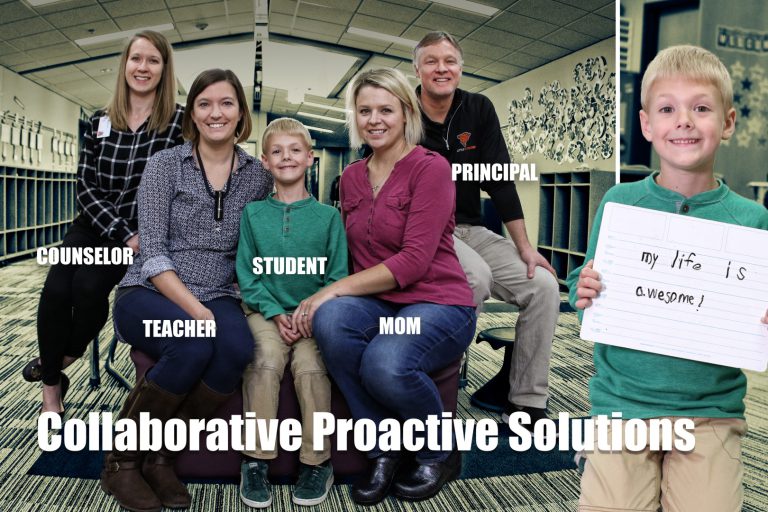

Collaborative Proactive Solutions

If a student is having difficulties in the area of math, no teacher would ever attribute that to the student not wanting to understand the subject. They would simply need additional resources to help them learn the concepts and to practice it. Principal Steve Flynn and his staff at Meeker Elementary are applying that principle to behavior as well based on the book Lost and Found: Helping Behaviorally Challenging Students (and, While You’re At It, All the Others) by Ross W. Greene.
“It really is a paradigm shift to how we address behavior within our school. It goes away from the traditional notion that students will do well if they want to do well, and instead suggests that students will do well if they can,” says Flynn. Last year, Flynn saw that traditional discipline was having a limited impact on students because they were being punished without a gameplan on how to equip students to manage their behavior. “We often assume that behavior is a student choice, so we think we need to come up with a bigger punishment.” Without educating students, the behavior and frustration only continues.
Collaborative Proactive Solutions (CPS) is the structure that Greene outlines in his book and it is being implemented across Meeker Elementary. All certified staff participated in a book study last year and began implementing aspects of the program toward the end of the year, with a full implementation taking place this year.
The core of the plan revolves around what are called ALSUP meetings, which is an acronym for Assessment of Lagging Skills and Unsolved Problems. In his book, Greene outlines a list of behaviors that teachers can use to start to pinpoint specific problems. Flynn said “This framework is to help staff get organized on how to help the student. They can be specific on what the problem is and can then prioritize what are the most beneficial to tackle first. We don’t want to overwhelm the student by trying to solve multiple problems at the same time.”
For example, let’s say that it has been identified that “Billy” has difficulties during transitions. He struggles when entering the classroom and when being instructed to get supplies out. Greene calls this an “unsolved” problem and the area where he is getting stuck. At the ALSUP meeting, all key staff would be involved in identifying expectations the student is struggling to meet. Then it is determined which unsolved problem would be the best to approach first. Members could include the teacher, school counselor, and principal, among many others.
During the “empathy” step, the teacher will meet with the student, first as an informal conversation. The goal is to ask questions of the student and to gain an understanding. The idea is to just listen, and not question what the student is saying. When Billy is done talking, the teacher can express their concerns with his behavior. The teacher could say “when you’re not getting your supplies out, you’re missing out on the activities that we are doing.” Once both sides are done, the goal is to find a solution that is beneficial to both the student and teacher during the “invitation” step.
This solution may not be exactly what the teacher would have come up with, but it does allow the student to have a voice in solving the problem, and therefore ownership in the results. In essence, it is a more indirect approach to teaching social skills. This approach to problem solving encompasses three key things for students: their flexibility, frustration tolerance, and problem solving skills. All of these things equip students with skills that are transferable across grades and for the remainder of their lives.
Working with student behaviors is an art, and no template will work exactly the same with every student and situation. That makes this approach a work in progress, but something that both Flynn and parents have seen as beneficial. Emily Tyndall is a parent of Benham, who is a first grader at Meeker Elementary and excited about the program. “Last year at a PTO meeting, Mr. Flynn introduced the book Lost in School (an earlier book by Dr. Greene), and I was so thrilled I ordered the book from Amazon before the meeting ended. To me, the most important point Greene makes is making sure we (parent or teacher) determine what the problem is instead of trying to solve the issue based on our own assumption.”
She admits that her son Benham has shown signs of ADHD, which can manifest in a number of ways that include impulsivity, defiance, inattention, and at times disruptive behavior. Once Emily started to ask questions that aligned with the CPS approach, she started to understand that he had concerns that had never crossed her mind. School counselor Kari Deal echoed that sentiment completely when she said, “We’re looking to discover the root of the unsolved problem rather than putting a bandage on the behavior.”
Emily continued by saying, “When you understand the problem you’re much more effective at solving it. I know Benham has benefited from this approach because he’s more communicative with his teacher and staff about his concerns and needs. He’s developed a deeper trust with those who use this collaborative strategy with him and I’m grateful for their commitment and support.”